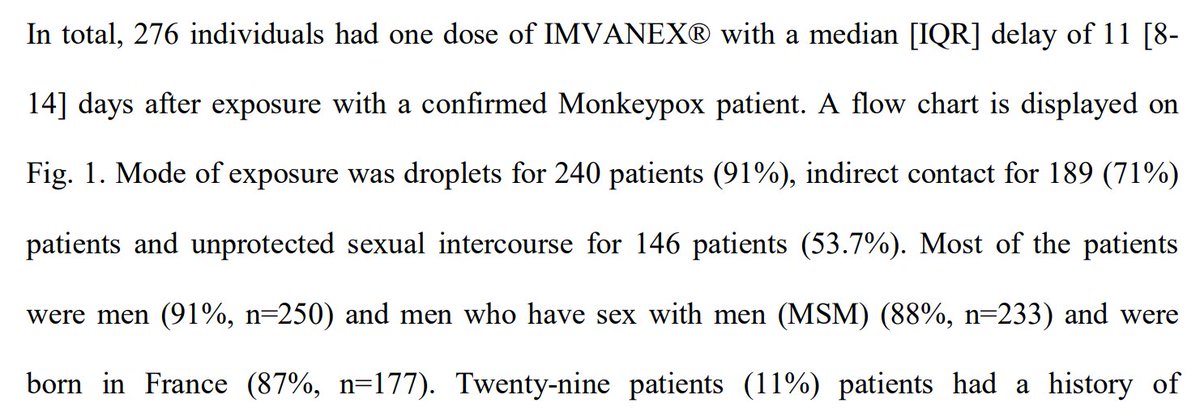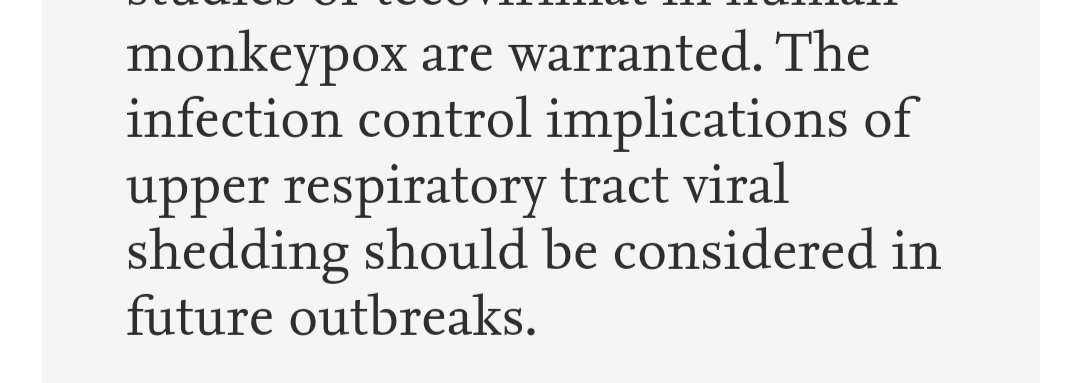
An breakthrough infection preprint that indicates #MonkeypoxIsAirborne, while showing breakthrough infections were 4%.
But airborne via aerosol infections could be as high as 46.1%
We arrive at that conclusion via their exposure definition, and data.
medrxiv.org/content/10.110…
But airborne via aerosol infections could be as high as 46.1%
We arrive at that conclusion via their exposure definition, and data.
medrxiv.org/content/10.110…
1. A high-risk contact defined as close skin-to-skin or
mucosal contact. (Sex and one accidental infection).
2. Dirty surfaces infection (fomite).
3. droplets exposure defined by a contact at less than 2 meters during at least 3 hours to a PCFR confirmed MPX patient.
Let's
mucosal contact. (Sex and one accidental infection).
2. Dirty surfaces infection (fomite).
3. droplets exposure defined by a contact at less than 2 meters during at least 3 hours to a PCFR confirmed MPX patient.
Let's

take a look at # 2 - t what we know about fomite infection.
Per the WHO it is at .2%.
Yet, in this study? They have it as "indirect contact for 189 (71%)"
Which means they asked if there were contaminated
Per the WHO it is at .2%.
Yet, in this study? They have it as "indirect contact for 189 (71%)"
Which means they asked if there were contaminated
https://twitter.com/LazarusLong13/status/1558260321558482945?s=20&t=4SxuhThvQImJpfGlZ2t0tg
surfaces in the location shared with the infected MPX patient.
That's it. Having reviewed the CDC's intake questions? It's easy to see how fomite and droplet biases underlay their data gathering and the final outcome.
Fortunately, this is not rocket science. Those WHO
That's it. Having reviewed the CDC's intake questions? It's easy to see how fomite and droplet biases underlay their data gathering and the final outcome.
Fortunately, this is not rocket science. Those WHO
numbers came from a much bigger effort. So, when the study reports that it was 71% indirect contact, but the WHO reports .2% ?
Clearly the .2% - or closer to it, is a better answer.
Clearly the .2% - or closer to it, is a better answer.
When we look the overall breakdown?
91% droplets (remember, this is the 3 hour, within 6 feet)
71% indirect contact.
53.7% sexual contact.
Clearly, there are some who were exposed in multiple ways.
Let's stipulate that sexual contact is 53.7%. despite the heavy breathing
91% droplets (remember, this is the 3 hour, within 6 feet)
71% indirect contact.
53.7% sexual contact.
Clearly, there are some who were exposed in multiple ways.
Let's stipulate that sexual contact is 53.7%. despite the heavy breathing

involved in close quarters & 2000 breaths exchanged in 1 hour of contact.
So, that leaves 46.3% left over.
If we take the .2% indirect contact/ fomite figure from the WHO, then that leave 46.1% left over to get to an actual 100%.
So, that leaves 46.3% left over.
If we take the .2% indirect contact/ fomite figure from the WHO, then that leave 46.1% left over to get to an actual 100%.
My point is to just show that airborne is happening. It doesn't matter if it only ends up being 25% - it's just a more sizable portion than people think.
So, we have 46.1% of transmission left over. And how was that defined?
So, we have 46.1% of transmission left over. And how was that defined?

"droplets exposure defined by a contact at less than 2 meters during at least 3 hours to a PCFR confirmed MPX patient."
If you were being hit in the eye or mouth by droplets from a close talker? No one just sits there getting spit on.
3 hours - this indicates that aerosols
If you were being hit in the eye or mouth by droplets from a close talker? No one just sits there getting spit on.
3 hours - this indicates that aerosols
were building in concentration.
Actual droplet infections happens in a flash.
So, this 3 hour finding is from epi data indicating that was the typical transmission time. Which could only be from aerosols.
#MonkeypoxIsAirborne could be as high as 46.1% of the cases here.
Actual droplet infections happens in a flash.
So, this 3 hour finding is from epi data indicating that was the typical transmission time. Which could only be from aerosols.
#MonkeypoxIsAirborne could be as high as 46.1% of the cases here.
And I get that not all will agree with this interpretation. That's ok. We can agree to disagree - like I do with the study's interpretation.
But study's authors biases are clear in favor of fomite or droplet, prima facie.
My bias is clearly in favor of aerosols. But I am
But study's authors biases are clear in favor of fomite or droplet, prima facie.
My bias is clearly in favor of aerosols. But I am
absolutely willing to concede the other forms of transmission play a role, and just urge the precautionary principle of masking.
Because in this case aerosols are somewhere between 0 and 53.7%. Fomites are going to be around .2%. Sexual is 53.7%.
Because in this case aerosols are somewhere between 0 and 53.7%. Fomites are going to be around .2%. Sexual is 53.7%.
If you knew you had a 10% of getting Monkeypox with a 10% chance of going blind afterwards? Would you mask?
If you knew you had a 10% of getting airborne Monkeypox, with the disfiguring pock marks? Would you mask?
I would.
If you knew you had a 10% of getting airborne Monkeypox, with the disfiguring pock marks? Would you mask?
I would.
But the CDC is not asking the right questions to determine what percentage is actually airborne.
https://twitter.com/LazarusLong13/status/1557537226254258177?s=20&t=4SxuhThvQImJpfGlZ2t0tg
• • •
Missing some Tweet in this thread? You can try to
force a refresh
















